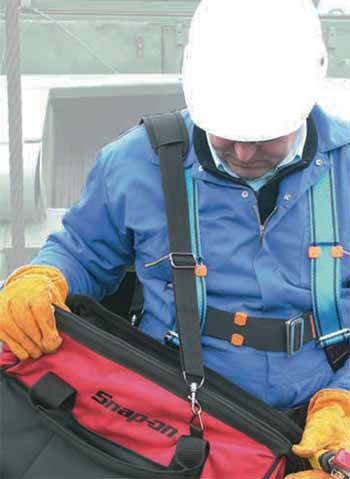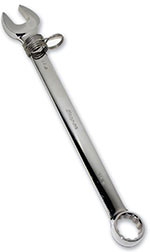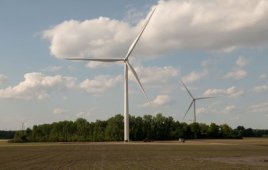A structure or machine that requires fasteners also demands tools to maintain it properly. In the wind-power industry, the machine could be 300 feet in the air, which presents a variety of safety and efficiency considerations. Snap-on Industrial has worked in industries ranging from oil and gas production to manufacturing facility maintenance, and so has developed the concept of tools-at-height to address these considerations. In an environment where it’s simply unacceptable to drop anything, tools-at-height means essentially eliminating the potential for damage from a dropped tool.
The problem
A tool security and drop-prevention system improves site safety. In the wind industry, it’s easy to see how this is manifested when a worker drops a tool or a part of one. In the confined space of a nacelle or tower, a dropped ratchet at height can do more than merely startle workers below. It can cause severe injury or death. The reality is that four pounds of steel ricocheting off equipment or flooring after a 300-ft fall can create something akin to shrapnel. Dropping something that creates debris is as dangerous as actually hitting someone with an object from above.
And what of the time wasted when a worker forgets a tool and is forced to make “the walk of death?” Such unplanned trips down a ladder or slow-moving lift to pick up a wrench or screwdriver no one thought to bring up can quickly fill a day.
In addition, forgetting a tool in a critical area can cause considerable damage. The confined environment of a nacelle has many places where workers can lose or forget small tools – until an accident happens.

Took kits in bags designed for particular tasks make it easier for wind technicians to carry the appropriate equipment.
A solution
One of the key parts of the tools-at-height concept is a lanyard or tether. Tools built specifically to accommodate the tether let the design maintain its strength and structural integrity. The tether can also attach to a wrist or tool belt, depending on tool weight and application.
Other components include coiled, weld-less fittings that are built as an integral part of a wrench, rather than a modification. The design uses an anchor attachment “floating” across the length of the tool for easy use and without modifications that could compromise tool strength. Lock-on retention safety pins essentially bind a socket to a ratchet wrench, a significant improvement over the conventional ball-retention method.
Custom tool kits based on specific applications are another part of the tools-at-height program. Snap-on Industrial works with users in a variety of industries to create kits that contain all the tools necessary to complete the task at hand. This lets wind industry workers know they need no additional equipment and will not have to come back down the ladder after reaching the nacelle. Along with reducing tool-toting time, a dedicated kit provides a secure transportation method and acts as an extension of a comprehensive asset-management program. Shockproof or waterproof cases are available with etched foam tool-control packing. This way, every tool has its place, so users know immediately if one is missing. It reduces the likelihood of losing a tool in the confined space of a wind turbine, thereby protecting the investment.
Learning from other industries

The sliding yet captured ring allows tethering the wrench to a technician which practically eliminates the possibity of dropping the tool.
Foreign Material Exclusion (FME), a term originated by the nuclear industry, is a set of procedures that minimize the contamination of a system by foreign materials. For example, a tool that falls into a nuclear facility’s cooling tank must be removed. This is difficult in a radioactive environment, and the task can be just as difficult in other industries. The extra cost in dollars and safety concerns can be significant when a tool ends up where it shouldn’t be.
FME is a big issue in other segments of the power-generation industry as well. What would a misplaced socket do in a wind turbine? What are the cost considerations in shutting down a turbine, not to mention the maintenance necessary to bring it back on line?
The idea for tethered tools came from NASA requirements in the early 1980s, primarily for work done on satellites. These are extremely delicate designs that involve a lot of last-minute wrench turning at launch time. A socket dropped on a solar panel can create millions of dollars in damage. In the case of a satellite, it means sending the entire assembly back to the manufacturer for a repair that could have been prevented.
The offshore-oil industry has working conditions similar to those in the wind industry: confined spaces, workers
laboring one above another, a tool-intensive workplace, and potential to damage sensitive equipment. In this environment, a dropped tool can hit someone below or fall into the ocean. The problem with a tool lost to the ocean is that the rig could be 150 miles offshore with workers and equipment shuttled in by helicopter once a week. Oil rigs have little space for extra tools so dropping even one can significantly impact worker productivity.
The lanyard represents a low-tech component of any tools-at-height program. A good system includes a drop indicator that opens if the lanyard becomes overstressed. The indicator usually consists of excess strap material folded over on the lanyard and held in place by a threaded stitch. The open indicator tells the user the application has exceeded one limit and is approaching the tether’s capacity.
The socket is a challenging tool because it is relatively small and cannot be tethered. A solution is a pin in the socket to hold it in place and attach it to the ratchet. In turn, the lanyard attaches to the ratchet and to the worker’s wrist or tool belt.

Tool cases like this one let wind technicians quickly check that all tools are present and accounted for.
The wind-power industry has the advantage of learning tool security from older industries. The lanyard, socket pin, and tools tethered to the tool belt are components of a comprehensive tool-security program that enhances workplace safety and overall efficiency. Amateur modifications of existing tools are not an option in an environment where mistakes can lead to system failure or worker injury. Specialized tools with dedicated tethering systems are intended for use in close quarters or at height, supporting foreign material exclusion. The goal is superior site and worker safety, as well as increased productivity. WPE
Filed Under: Uncategorized






